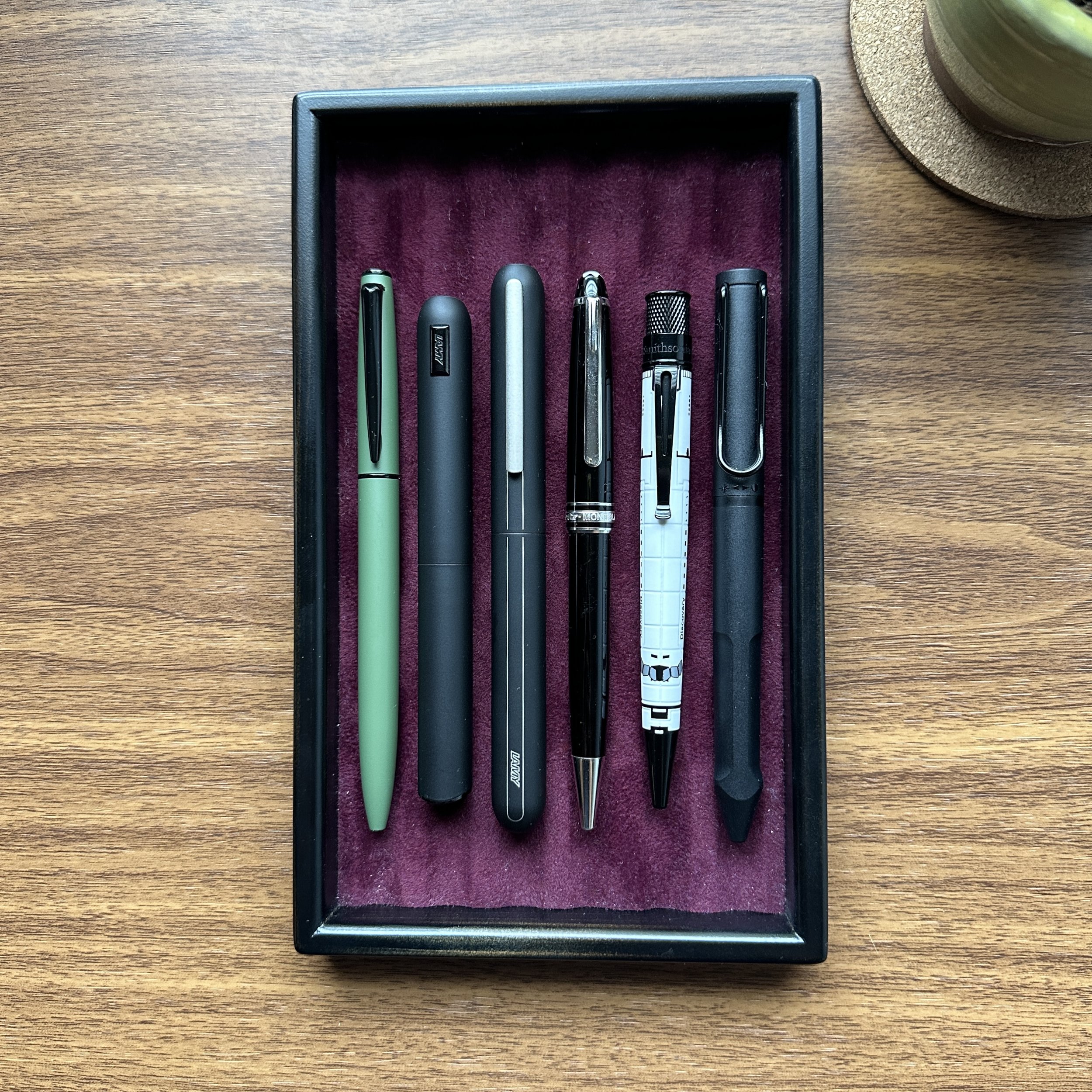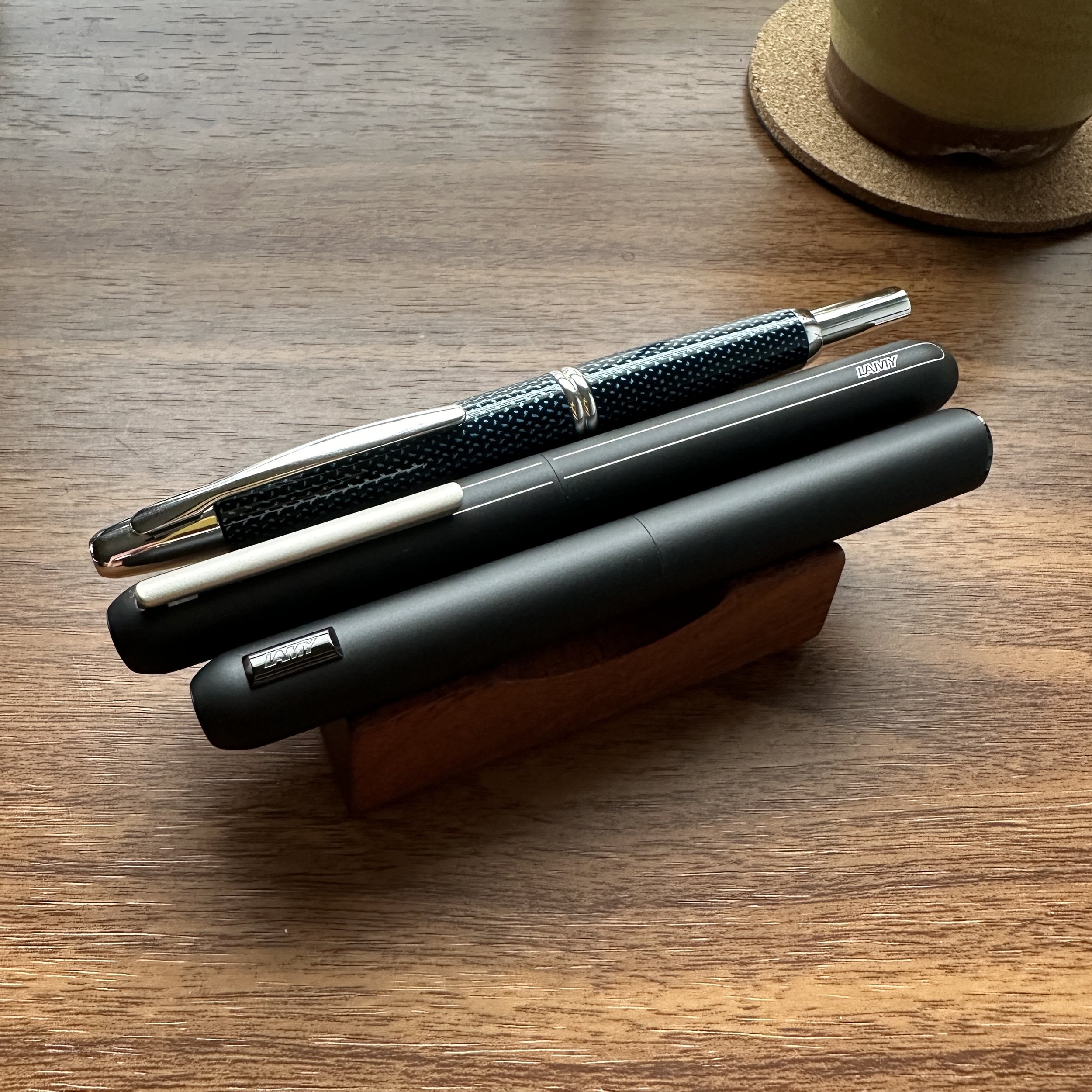Within the broader world of pens, enthusiasts have many different choices to make. Fountain pen, rollerball, or ballpoint? Bottled fountain pen ink or ink cartridge? Post your pens or don’t post your pens? There’s no “right” answer, as all of these end up being matters of personal preference (though heatedly debated online). One discussion, however, has been the subject of surprisingly little conversation throughout my years in the community: the pros and cons of different retractable pen mechanisms.
Why Does The Mechanism Matter?
To begin, let’s assume that you’ve already decided that you want a retractable pen vs. a capped pen. You do most of your writing “on the go,” whether that be in the field, in the car, in the kitchen, standing at the back of a crowded boardroom holding a clipboard, etc. You need a pen that you can quickly deploy, that writes reliably, and where you don’t need to worry about keeping track of a loose cap. Retractable it is!
Both click pens and twist pens come in a wide range of formats, but pens within each category typically share a few things in common.
But many different pens are “retractable.” You have the classic click pen, and within that category, many more sub-categories of different click mechanisms (including not just the classic bolt-action pens and “side-click” pens with release buttons). The second largest group of retractable pens are twist-activated, which typically involves turning part of the barrel to deploy the refill - or in the case of a twist-retractable fountain pen like the Lamy Dialog3 - the nib. Each category has its own set of considerations, and while I personally use both, the “better choice” for you is definitely context-dependent.
Six Click Pens, from Left: Caran d’Ache 849 Paul Smith; Lamy 2000 Ballpoint, Anterique Ballpoint, Pilot G2 Limited, Pilot Vanishing Point, Tombow Airpress (a/k/a the greatest fidget toy of all times - that knock is addictive!)
The Pros and Cons of the “Click Pen”
This article won’t dive into the particularities, advantages, and disadvantages of different styles of click-mechanism: that’s a rabbit hole for another day. But in general, I’m referring to any pen that allows you to click a button at the end of the pen to deploy the tip or nib. Examples of common click pens in this category include: the vintage-style Bic Clic (Field Notes version and countless other Clic-inspired pens like those from Anterique); Pilot G2/Zebra Sarasa/similar gel pens; Caran d’Ache 849 (both ballpoint and rollerball); the Lamy Safari Ballpoint, and on the fountain pen side, pens like the Pilot Vanishing Point/Decimo and the Platinum Curidas.
Why write with a click pen?
Speed. If what you’re looking for is a writing instrument that allows you to get writing quickly with little to no fuss, you need a click pen. The classic example is the newspaper reporter in the field, pairing a Bic Clic with a spiral bound reporter’s notebook. Clicking the end of the pen to extend/retract the tip takes no time at all.
Ease of Use, Especially One-Handed. I spend a lot of time writing while standing, holding a legal pad or portfolio in one hand and a pen in the other. In addition to speed, a click-pen allows you to operate the pen one handed.
Low Cost. Click pens are generally less expensive than other options, as most mechanisms are mass-produced. As noted below in the “twist-pen” discussion, this can lead to long-term durability issues, but you still have to work pretty hard to wear out even the cheapest click pen.
The main drawback to a click mechanism is that it’s easy to accidentally deploy the refill in your pocket or bag. While not a huge deal with a ballpoint or gel pen, both of which use more viscous inks, this type of “inkcident” can be disastrous with a liquid ink pen such as a capless rollerball or fountain pen. I’ve personally ruined countless pairs of pants by carrying click pens in my pocket, to the point where I hardly use capless rollerball refills anymore and have mostly moved to low-viscosity ballpoint cartridges in all of my click pens. (If a capless fountain pen like a Vanishing Point accidentally deploys, you can also bend the nib, but it’s much less common for people to try to carry these pens loose in a pocket or bag because they’re more expensive.)
Six twist pens, from left: Uni Jetstream Prime, Lamy Dialog CC, Lamy Dialog3, Montblanc Classique Ballpoint, Retro 51 Tornado, Lamy Safari Twin Pen 2-in-1.
The Pros and Cons of a Twist Pen
If you enjoy pocket carry, or like to store pens in pen loops or slots built into your bags and/or portfolios, you might prefer a pen with a twist-action mechanism. The main advantage for me personally is that there is a lower risk of accidentally engaging the mechanism and having ink from the refill leak into the interior of your bag or pocket. While it’s a bit more difficult to use the pen one-handed, many people prefer the streamlined design of twist pens over the somewhat inelegant push-button knock. Examples of common twist-action pens include fancier options from Montblanc and Waterman, as well as less expensive pens like the Uni Jetstream Prime, the Baron Fig Squire, and the Retro 51 Tornado.
Uni’s Jetstream Prime is a slim ballpoint with an excellent refill and a great price point.
Why Write with a Twist Pen?
Lower Risk of Ruining Your Bag or Clothing. As noted above, this one is fairly straightforward. It’s much more difficult for a twist pen to accidentally deploy, though of course it can happen. (To be absolutely safe, I often recommend that people only carry capped pens in their pockets.)
Increased Durability. Click mechanisms tend to wear out. Most of the parts used in lower-cost, mainstream pens are mass-produced and not designed to last forever. Combined with the tendency to use pens as fidget toys, most click pens will eventually break. In my personal experience twist-action pens have fewer moving parts and therefore last longer. Some of my nicer twist ballpoints, such as my Montblanc 144 “Classique” and Waterman Expert, are upwards of 25 years old. And don’t get me started on all those Cross Century and Century II pens from the 1960s….
Streamlined Design. Without the need for a button (or “knock”) at the end, twist pens can adopt more elegant, streamlined designs. The difference is especially apparent when you get into higher-end writing instruments. For example, Pilot does an excellent job incorporating the knock into the design of the Vanishing Point and Decimo, but Lamy scores points for the design work on their twist-action “Dialog” series.
As good as they look, the Lamy Dialog pens also make my point about click pens being a lower-cost option: The Lamy Dialog CC and Dialog 3 can cost as much as 2x the Pilot Vanishing Point.
Did You Enjoy This post? Come See Me This Week at the California Pen Show!
The primary focus of The Gentleman Stationer, both the informational site our curated retail shop, is to help people find practical stationery that fits their everyday writing needs. I firmly believe that stationery is meant to be used, not just hoarded or collected, and I approach everything from the perspective of an everyday user as well as an enthusiast. Retractable pens are one of those ubiquitous items that everyone uses - typically without thinking much about it - though with just a bit of thought and consideration you might be able to upgrade your writing experience even more. There are so many different options out there!
Today’s post on retractable pens is just one of many different topics I’ll be discussing in my seminar "Stationery for Everyday Writing: Choosing Pens, Inks, and Paper for Your Daily Life”. I have two time slots: 2:30pm PT on Friday and 11:00 am PT on Saturday. I’ll also be hosting the “Pen Shows After Dark” event on Friday, which will be on-site at the show hotel. There’s no cost to attend any of the events I’m participating in, so please do stop by!
The Gentleman Stationer is supported entirely by purchases from the T.G.S. Curated Shop and pledges via the T.G.S. Patreon Program.










